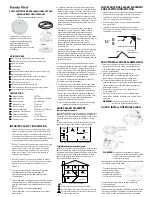
D150-03-00 REV: 001
2
I56-1030-000
Installation Guidelines
NOTE: Refer to the releasing device manufacturer’s in-
structions for connection instructions.
Allowable loop resistance is an important specification for
control panels as well as for smoke detectors and their
bases. The alarm system cannot be expected to oper-
ate correctly if system components have incompatible
allowable loop resistances. Therefore, before beginning
installation, refer to the control panel manufacturer’s loop
resistance specification to ensure that it is listed as com
-
patible with the System Sensor base and smoke detector
being installed.
All wiring must be installed in compliance with the Ca-
nadian Electrical Code, all applicable local codes and any
special requirements of the authority having jurisdiction,
using the proper wire size. The conductors used to con-
nect smoke detectors to control panels and accessory
devices should be color-coded to reduce the likelihood of
wiring errors. Improper connections can prevent a system
from responding properly in the event of a fire.
Wiring
For signal wiring (the wiring between interconnected
detectors), it is recommended that the wire be no smaller
than AWG 18. However, the screws and clamping plate
in the base can accommodate wire sizes up to AWG 12.
The use of twisted pair wiring for the power (+ and -)
loop is recommended to minimize the effects of electrical
interference.
NOTE:
To ensure that electrical connections are super-
vised, DO NOT loop wires under terminals 2, 3,
and 5 –break the wire at each terminal.
To make electrical connections, strip approximately 3/8" (1
cm) insulation from the end of each wire. Slide the wires
under the clamp plate and tighten the terminal screw.
If the base is being installed in a zoned system, check the
zone wiring before installing the smoke detector head. The
built-in shorting spring makes it convenient to do this. After
the detector base is wired and attached to the electrical
box, position the shorting spring against terminal 3. Use
the slot in the retaining clip to hold the spring against the
terminal, as shown in Figure 1. This shorts the negative-in
and negative-out leads so that loop wiring can be tested
for continuity.
The shorting spring in the base will disengage automatically
when the detector head is removed from the base. DO
NOT remove the shorting spring since it reengages as
the detector head is turned into the base, completing the
circuit.
Tamper-resistance Feature
NOTE:
DO NOT use the tamper-resistance feature if the
SNAP ON
DECORATIVE
RING
SCREWS (NOT
SUPPLIED)
DETECTOR
BASE
BOX (NOT
SUPPLIED)
SHORTING
SPRING
A78-1175-01
Figure 1. Mounting base to box:
System Sensor XR2 Removal Tool will be used to
remove detectors from the base.
This detector base can be made tamper resistant so the
detector cannot be removed without the use of a tool. To
make the base tamper-resistant, break off the smaller tab
at the scribed line on the tamper-resistance tab, on the de-
tector mounting bracket (see Figure 3A), before installing
the detector.
To remove the detector from the base after it has been
made tamper resistant, remove the decorative ring by
rotating it in either direction and pulling it away from the
base. Then, insert a small screwdriver into the notch, as
indicated in figure 3B, and press the plastic lever toward
the mounting surface before rotating the detector counter-
clockwise for removal.






















